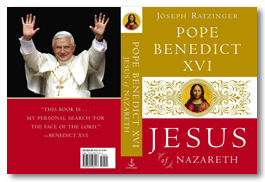Preface from Jesus of Nazareth
- JOSEPH RATZINGER/POPE BENEDICT XVI
I came to this book about Jesusthe first part of which I now present to the publicafter a long interior journey.
 |
In the time of my youthduring the 1930s and 40sthere was published a series of exhilarating books about Jesus. I recall the names of just a few authors: Karl Adam, Romano Guardini, Franz Michel Willam, Giovanni Papini, Jean-Daniel Rops. In all these books, the image of Jesus Christ was outlined beginning with the Gospels: how He lived upon the earth and how, although He was truly man, He at the same time brought God to men, being one with God as Son of God. Thus, through the man Jesus, God became visible, and beginning with God one could see the image of the just man.
Beginning in the 1950s, the situation changed. The rift between the historical Jesus and the Christ of faith became wider and wider; the one pulled away from the other before ones very eyes. But what meaning can there be in faith in Jesus Christ, in Jesus the Son the of living God, if the man Jesus is so different from how the evangelists present Him, and from how the Church proclaims Him on the basis of the Gospels?
Progress in historical-critical research led to increasingly subtle distinctions among the different levels of tradition. Behind these layers, the figure of Jesus, upon whom faith rests, became increasingly more uncertain, and took on increasingly less definite outlines.
At the same time, the reconstructions of this Jesus, who had to be sought behind the traditions of the Evangelists and their sources, became increasingly contradictory: from the revolutionary enemy of the Romans who opposed the established power and naturally failed, to the meek moralist who permitted everything and inexplicably ended up causing his own ruin.
Those who read a certain number of these reconstructions one after another will immediately notice that these are much more the snapshots of the authors and their ideals than they are the unveiling of an icon that has become confused. In the meantime, distrust has grown toward these images of Jesus, and in any case the figure of Jesus has withdrawn from us even more.
All of these attempts have, in any case, left behind themselves as their common denominator the impression that we know very little for sure about Jesus, and that it was only later that faith in His divinity shaped His image. This impression, in the meantime, has deeply penetrated the general consciousness of Christianity.
Such a situation is dramatic for the faith because it renders uncertain its authentic point of reference: intimate friendship with Jesus, on which everything depends, threatens to become a groping around in the void.
I felt the need to provide the readers with these indications of method because these determine the route of my interpretation of the figure of Jesus in the New Testament.
For my presentation of Jesus, this means above all that I trust the Gospels. Naturally, I take for granted what the Council and modern exegesis say about the literary genres, about the intention of various expressions, about the communitarian context of the Gospels and the fact that they speak within this living context. While accepting all this as much as possible, I wanted to make an effort to present the Jesus of the Gospels as the real Jesus, as the historical Jesus in the real sense of the expression.
I am convincedand I hope that I can also make the reader aware of thisthat this figure is much more logical, and from the historical point of view also more understandable, than the reconstructions we have had to confront in recent decades.
I maintain that this very Jesusthe Jesus of the Gospelsis an historically sensible and convincing figure. His crucifixion and the impact that he had can only be explained if something extraordinary happened, if the figure and the words of Jesus radically exceeded the hopes and expectations of his time.
Around twenty years after the death of Jesus, we find already in the great hymn to Christ in the Letter to the Philippians (2:6-8) the full expression of a Christology, in which it is said of Jesus that He was equal to God but stripped Himself, became man, and humbled Himself to the point of death on the cross, and that to Him is due the homage of creation, the adoration that in the prophet Isaiah (45:23) God proclaimed as due to Himself alone.
Critical research quite rightly poses this question: what happened in those twenty years after the crucifixion of Jesus? How did this Christology develop?
The action of anonymous communitarian formations, whose representatives are being sought out, in reality doesnt explain anything. How could unknown groups be so creative, how could they be convincing and impose themselves? Isnt it more logical, even from the historical point of view, to suppose that the great impulse came at the beginning, and that the figure of Jesus burst beyond all of the available categories, and could thus be understood only by beginning from the mystery of God?
I have sought only to go beyond mere historical-critical interpretation, applying the new methodological criteria that allow us to make a properly theological interpretation of the Bible that naturally requires faith, without thereby wanting or being able in any way to renounce historical seriousness.
What then becomes clear is the multilevel struggle present in the writings of the New Testament over the figure of Jesus, and despite all the differences, the profound agreement of these writings.
It is clear that with this view of the figure of Jesus I go beyond what Schnackenburg, for example, says in representation of a good portion of contemporary exegesis.
I hope, however, that the reader understands that this book was not written against modern exegesis, but with great recognition of all this has given and continues to give to us. It has made us familiar with a great quantity of sources and conceptions through which the figure of Jesus can become present to us with a liveliness and depth that we couldnt even imagine just a few decades ago.
I have sought only to go beyond mere historical-critical interpretation, applying the new methodological criteria that allow us to make a properly theological interpretation of the Bible that naturally requires faith, without thereby wanting or being able in any way to renounce historical seriousness.
Of course, it goes without saying that this book is absolutely not a magisterial act, but is only the expression of my personal search for the face of the Lord (Psalm 27:8). So everyone is free to disagree with me. I ask only that my readers begin with that attitude of good will without which there is no understanding.
As I said at the beginning of the preface, my interior journey toward this book was a long one.
I was able to begin working on it during summer vacation in 2003. In August of 2004, I gave definitive form to chapters 1 through 4. After my election to the episcopal see of Rome, I used all of my free moments to carry the project forward.
Because I do not know how much more time and strength will be granted to me, I have now decided to publish the first ten chapters as the first part of the book, going from the baptism in the Jordan to the confession of Peter and the Transfiguration.
Rome, the feast of Saint Jerome
September 30, 2006
 This is Meaghen Gonzalez, Editor of CERC. I hope you appreciated this piece. We curate these articles especially for believers like you.
This is Meaghen Gonzalez, Editor of CERC. I hope you appreciated this piece. We curate these articles especially for believers like you.
Please show your appreciation by making a $3 donation. CERC is entirely reader supported.

Acknowledgement
Joseph Ratzinger/Pope Benedict XVI. "Preface" from Jesus of Nazareth (Doubleday: 2007).
Translation provided by Chiesa.com.
The Author

 Pope Benedict XVI is the author of Jesus of Nazareth, Vol II, Jesus of Nazareth, Vol I, Caritas in Veritate: Charity in Truth, Saved in Hope: Spe Salvi, God Is Love: Deus Caritas Est,The End of Time?: The Provocation of Talking about God, Truth and Tolerance: Christian Belief and World Religions, Without Roots: The West, Relativism, Christianity, Islam, Salt of the Earth: An Exclusive Interview on the State of the Church at the End of the Millennium, God and the World: Believing and Living in Our Time, In the Beginning: A Catholic Understanding of the Story of Creation and the Fall, The Spirit of the Liturgy, The Ratzinger Report: An Exclusive Interview on the State of the Church, Introduction to the Catechism of the Catholic Church, Introduction to Christianity, Called to Communion: Understanding the Church Today, Milestones: Memoirs 1927-1977, Behold the Pierced One, and God Is Near Us: The Eucharist, the Heart of Life.
Pope Benedict XVI is the author of Jesus of Nazareth, Vol II, Jesus of Nazareth, Vol I, Caritas in Veritate: Charity in Truth, Saved in Hope: Spe Salvi, God Is Love: Deus Caritas Est,The End of Time?: The Provocation of Talking about God, Truth and Tolerance: Christian Belief and World Religions, Without Roots: The West, Relativism, Christianity, Islam, Salt of the Earth: An Exclusive Interview on the State of the Church at the End of the Millennium, God and the World: Believing and Living in Our Time, In the Beginning: A Catholic Understanding of the Story of Creation and the Fall, The Spirit of the Liturgy, The Ratzinger Report: An Exclusive Interview on the State of the Church, Introduction to the Catechism of the Catholic Church, Introduction to Christianity, Called to Communion: Understanding the Church Today, Milestones: Memoirs 1927-1977, Behold the Pierced One, and God Is Near Us: The Eucharist, the Heart of Life.




